Strategic Management Report
VerifiedAdded on 2020/02/05
|7
|1499
|103
Report
AI Summary
This report analyzes the strategic management of Unilever and Cadbury. It examines Cadbury's objectives and Unilever's vision and mission, applying Porter's Five Forces framework to assess Cadbury's competitive environment. The report also includes a competitor analysis, focusing on Unilever's rivalry with Nestle in the ice cream market. The conclusion highlights the importance of addressing competitive pressures to enhance efficiency and product offerings. The report utilizes various academic sources and annual reports to support its analysis.
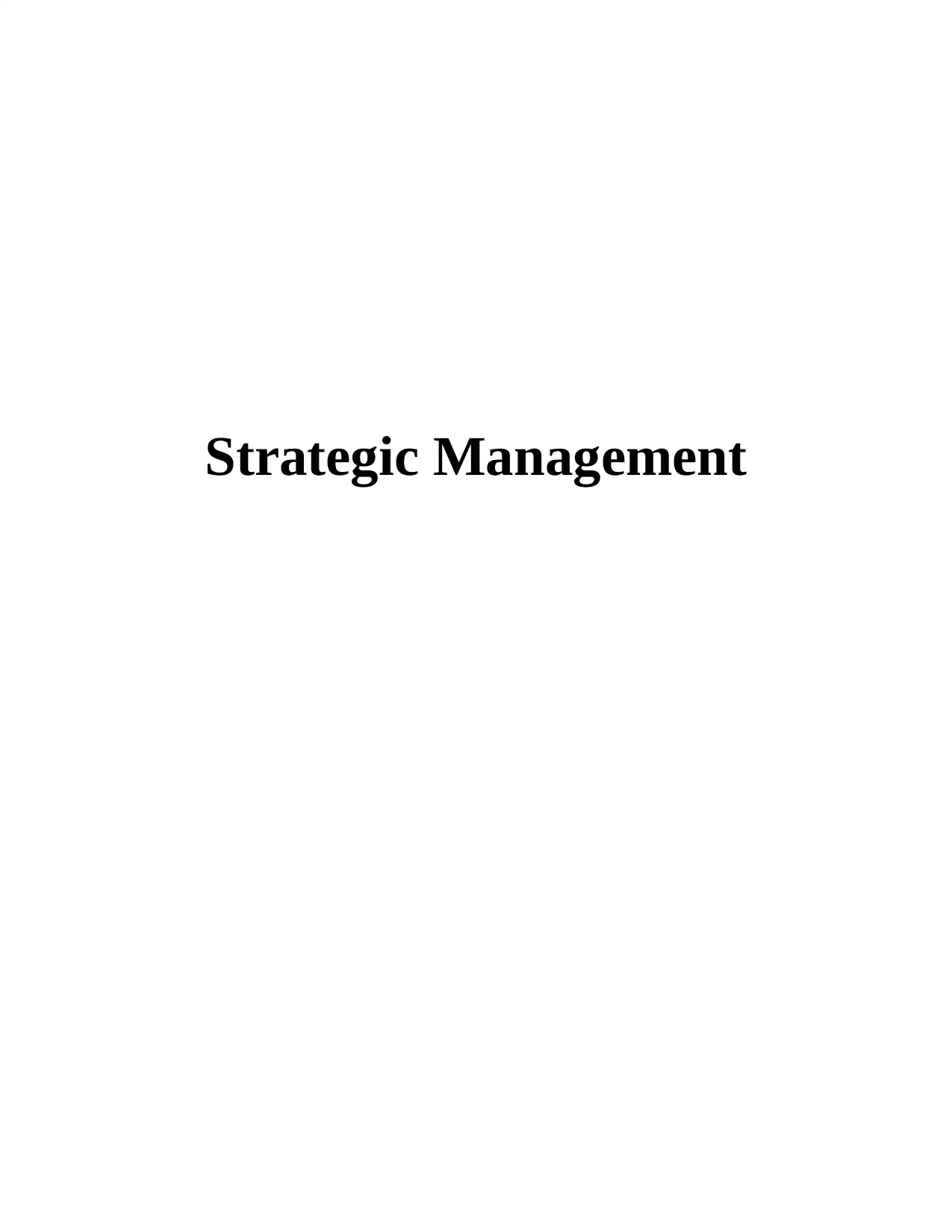
Strategic Management
Paraphrase This Document
Need a fresh take? Get an instant paraphrase of this document with our AI Paraphraser
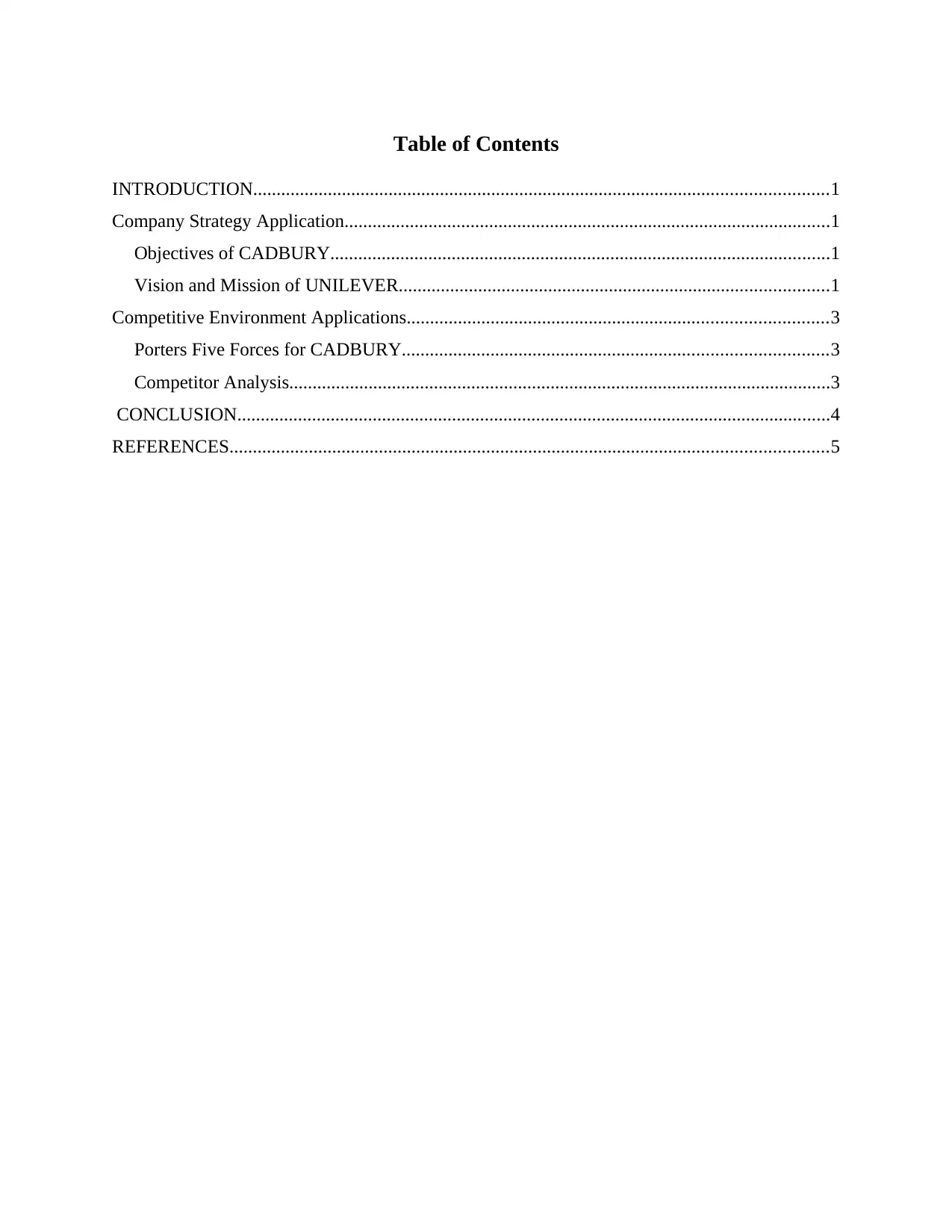
Table of Contents
INTRODUCTION...........................................................................................................................1
Company Strategy Application........................................................................................................1
Objectives of CADBURY...........................................................................................................1
Vision and Mission of UNILEVER............................................................................................1
Competitive Environment Applications..........................................................................................3
Porters Five Forces for CADBURY...........................................................................................3
Competitor Analysis....................................................................................................................3
CONCLUSION...............................................................................................................................4
REFERENCES................................................................................................................................5
INTRODUCTION...........................................................................................................................1
Company Strategy Application........................................................................................................1
Objectives of CADBURY...........................................................................................................1
Vision and Mission of UNILEVER............................................................................................1
Competitive Environment Applications..........................................................................................3
Porters Five Forces for CADBURY...........................................................................................3
Competitor Analysis....................................................................................................................3
CONCLUSION...............................................................................................................................4
REFERENCES................................................................................................................................5
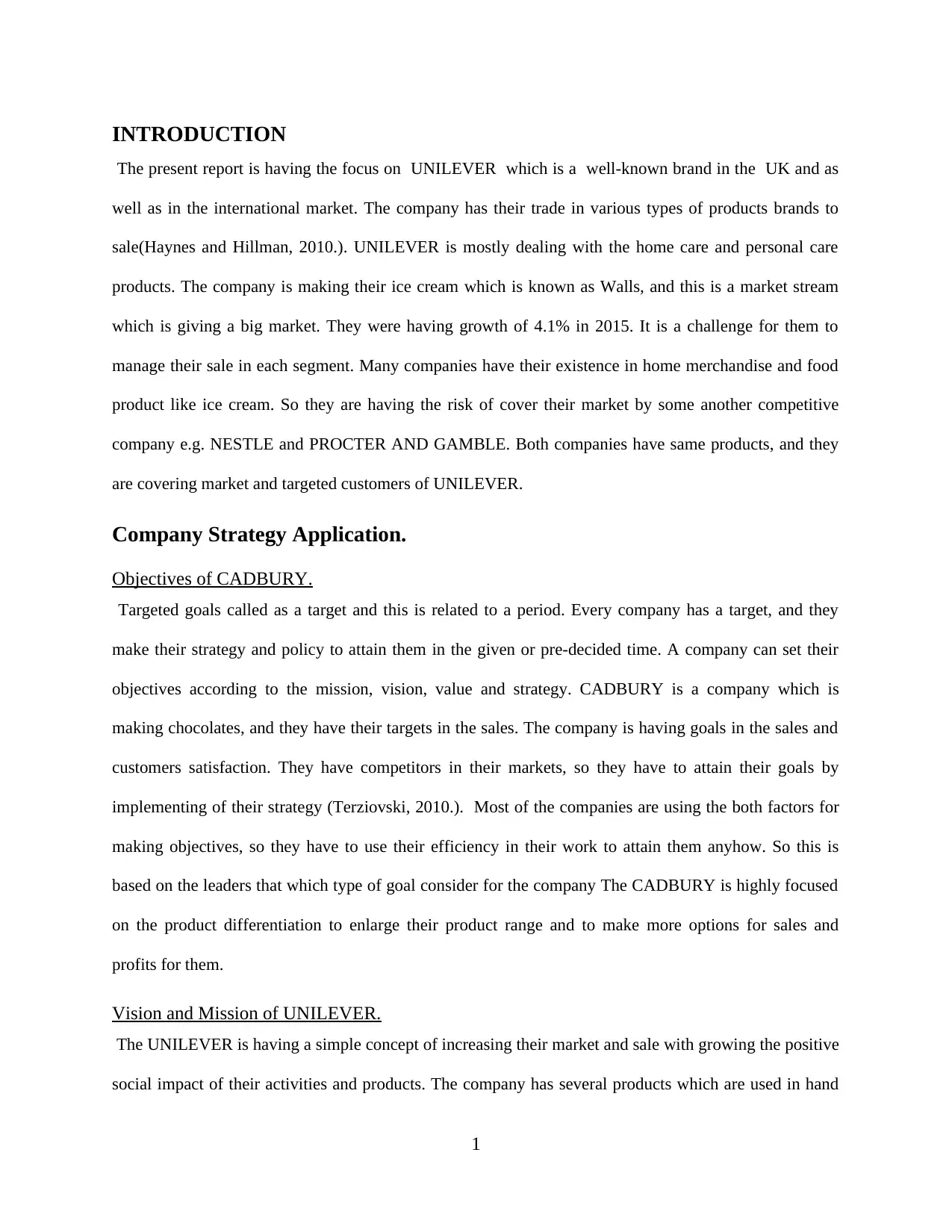
INTRODUCTION
The present report is having the focus on UNILEVER which is a well-known brand in the UK and as
well as in the international market. The company has their trade in various types of products brands to
sale(Haynes and Hillman, 2010.). UNILEVER is mostly dealing with the home care and personal care
products. The company is making their ice cream which is known as Walls, and this is a market stream
which is giving a big market. They were having growth of 4.1% in 2015. It is a challenge for them to
manage their sale in each segment. Many companies have their existence in home merchandise and food
product like ice cream. So they are having the risk of cover their market by some another competitive
company e.g. NESTLE and PROCTER AND GAMBLE. Both companies have same products, and they
are covering market and targeted customers of UNILEVER.
Company Strategy Application.
Objectives of CADBURY.
Targeted goals called as a target and this is related to a period. Every company has a target, and they
make their strategy and policy to attain them in the given or pre-decided time. A company can set their
objectives according to the mission, vision, value and strategy. CADBURY is a company which is
making chocolates, and they have their targets in the sales. The company is having goals in the sales and
customers satisfaction. They have competitors in their markets, so they have to attain their goals by
implementing of their strategy (Terziovski, 2010.). Most of the companies are using the both factors for
making objectives, so they have to use their efficiency in their work to attain them anyhow. So this is
based on the leaders that which type of goal consider for the company The CADBURY is highly focused
on the product differentiation to enlarge their product range and to make more options for sales and
profits for them.
Vision and Mission of UNILEVER.
The UNILEVER is having a simple concept of increasing their market and sale with growing the positive
social impact of their activities and products. The company has several products which are used in hand
1
The present report is having the focus on UNILEVER which is a well-known brand in the UK and as
well as in the international market. The company has their trade in various types of products brands to
sale(Haynes and Hillman, 2010.). UNILEVER is mostly dealing with the home care and personal care
products. The company is making their ice cream which is known as Walls, and this is a market stream
which is giving a big market. They were having growth of 4.1% in 2015. It is a challenge for them to
manage their sale in each segment. Many companies have their existence in home merchandise and food
product like ice cream. So they are having the risk of cover their market by some another competitive
company e.g. NESTLE and PROCTER AND GAMBLE. Both companies have same products, and they
are covering market and targeted customers of UNILEVER.
Company Strategy Application.
Objectives of CADBURY.
Targeted goals called as a target and this is related to a period. Every company has a target, and they
make their strategy and policy to attain them in the given or pre-decided time. A company can set their
objectives according to the mission, vision, value and strategy. CADBURY is a company which is
making chocolates, and they have their targets in the sales. The company is having goals in the sales and
customers satisfaction. They have competitors in their markets, so they have to attain their goals by
implementing of their strategy (Terziovski, 2010.). Most of the companies are using the both factors for
making objectives, so they have to use their efficiency in their work to attain them anyhow. So this is
based on the leaders that which type of goal consider for the company The CADBURY is highly focused
on the product differentiation to enlarge their product range and to make more options for sales and
profits for them.
Vision and Mission of UNILEVER.
The UNILEVER is having a simple concept of increasing their market and sale with growing the positive
social impact of their activities and products. The company has several products which are used in hand
1
⊘ This is a preview!⊘
Do you want full access?
Subscribe today to unlock all pages.

Trusted by 1+ million students worldwide
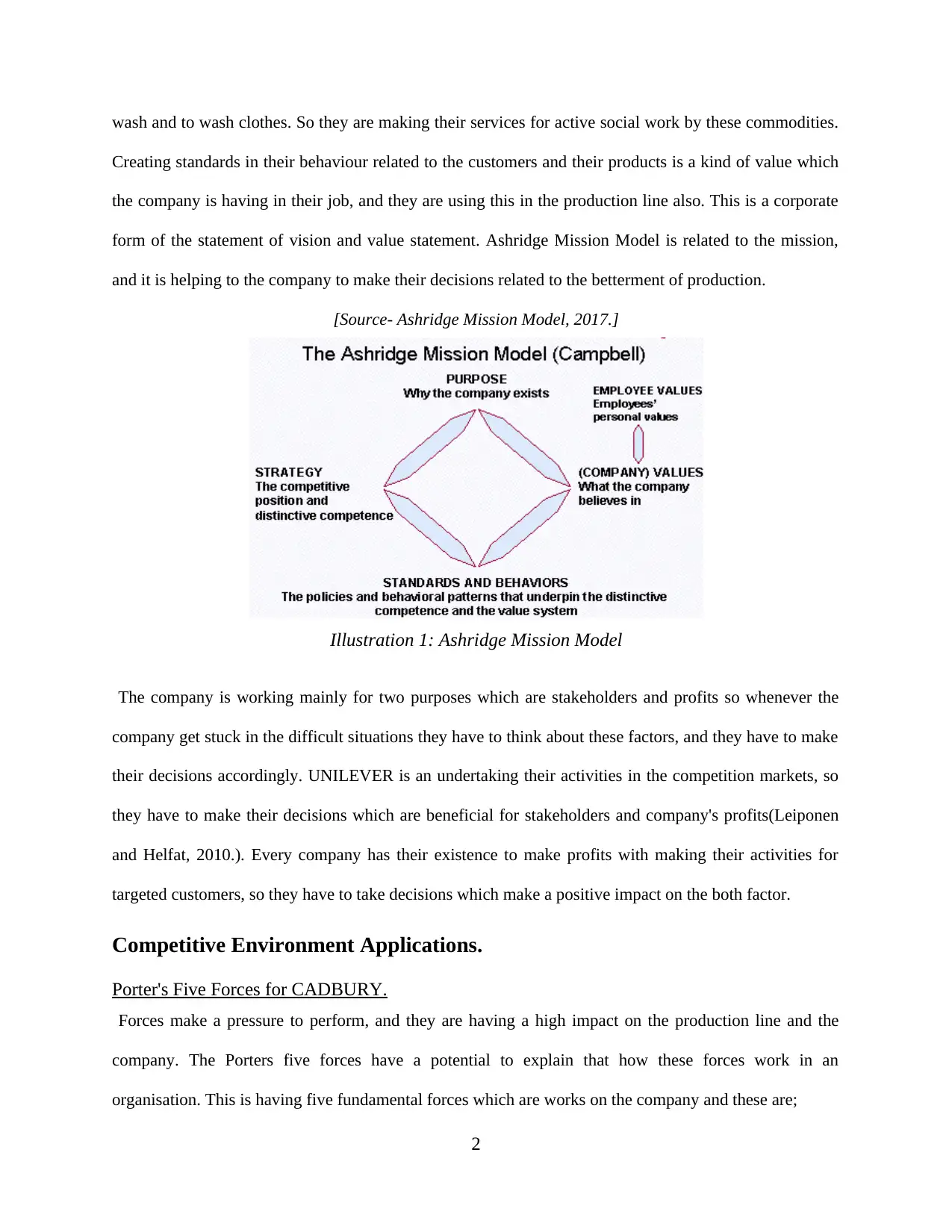
wash and to wash clothes. So they are making their services for active social work by these commodities.
Creating standards in their behaviour related to the customers and their products is a kind of value which
the company is having in their job, and they are using this in the production line also. This is a corporate
form of the statement of vision and value statement. Ashridge Mission Model is related to the mission,
and it is helping to the company to make their decisions related to the betterment of production.
[Source- Ashridge Mission Model, 2017.]
The company is working mainly for two purposes which are stakeholders and profits so whenever the
company get stuck in the difficult situations they have to think about these factors, and they have to make
their decisions accordingly. UNILEVER is an undertaking their activities in the competition markets, so
they have to make their decisions which are beneficial for stakeholders and company's profits(Leiponen
and Helfat, 2010.). Every company has their existence to make profits with making their activities for
targeted customers, so they have to take decisions which make a positive impact on the both factor.
Competitive Environment Applications.
Porter's Five Forces for CADBURY.
Forces make a pressure to perform, and they are having a high impact on the production line and the
company. The Porters five forces have a potential to explain that how these forces work in an
organisation. This is having five fundamental forces which are works on the company and these are;
2
Illustration 1: Ashridge Mission Model
Creating standards in their behaviour related to the customers and their products is a kind of value which
the company is having in their job, and they are using this in the production line also. This is a corporate
form of the statement of vision and value statement. Ashridge Mission Model is related to the mission,
and it is helping to the company to make their decisions related to the betterment of production.
[Source- Ashridge Mission Model, 2017.]
The company is working mainly for two purposes which are stakeholders and profits so whenever the
company get stuck in the difficult situations they have to think about these factors, and they have to make
their decisions accordingly. UNILEVER is an undertaking their activities in the competition markets, so
they have to make their decisions which are beneficial for stakeholders and company's profits(Leiponen
and Helfat, 2010.). Every company has their existence to make profits with making their activities for
targeted customers, so they have to take decisions which make a positive impact on the both factor.
Competitive Environment Applications.
Porter's Five Forces for CADBURY.
Forces make a pressure to perform, and they are having a high impact on the production line and the
company. The Porters five forces have a potential to explain that how these forces work in an
organisation. This is having five fundamental forces which are works on the company and these are;
2
Illustration 1: Ashridge Mission Model
Paraphrase This Document
Need a fresh take? Get an instant paraphrase of this document with our AI Paraphraser

Entry of new competitors; Chocolates are having a full growth market, and it is a product which
is having many customers(Helfat and Winter, 2011.). Many companies are trying to enter in this market,
and it is decreasing the market share of the CADBURY.
Threats of substitutes; CADBURY has many popular brands, e.g., Kitkat and Dairy Milk. To use
its popularity many local companies are making duplicate chocolates and selling it on the lower price so it
is doing a risk of reducing sale for CADBURY.
Bargaining power of buyers; Cost is not a matter for a consumer but the competitive products are
going to negotiate Ford, their customers. The company is not having higher prices of their products, and
they have an extensive range in the distinct price range, so there is no chance for bargaining for their
consumers, but they have to concern about competitive companies.
Bargaining power of suppliers; the Raw material is a need to make products, and the CADBURY
is having products like; milk and cocoa. The company is having a huge sale, so they have to purchase raw
material in bulk and at the lower prices(Zhou and Wu, 2010.). Sometimes not possible for their suppliers
to supply them immediately, so company have to make adjustments with the others.
Rivalry; Many companies are trying to cover the market share of the CADBURY so they have to
aware about it and they have to make changes in their products to increase their taste.
Competitor Analysis.
UNILEVER is having many competitors in the markets which are making same products. So
they have to make a distinction in between their products. So they have to focus on their
competitors and their similar products and try to create a difference in price and quality which
can be considered by the customers. UNILEVER is having a competition with the Nestle in ice
creams, so they have to use a strategy to make a difference in both(Freeman, 2010.). NESTLE is
having the same type of taste and price to cover the market.
3
is having many customers(Helfat and Winter, 2011.). Many companies are trying to enter in this market,
and it is decreasing the market share of the CADBURY.
Threats of substitutes; CADBURY has many popular brands, e.g., Kitkat and Dairy Milk. To use
its popularity many local companies are making duplicate chocolates and selling it on the lower price so it
is doing a risk of reducing sale for CADBURY.
Bargaining power of buyers; Cost is not a matter for a consumer but the competitive products are
going to negotiate Ford, their customers. The company is not having higher prices of their products, and
they have an extensive range in the distinct price range, so there is no chance for bargaining for their
consumers, but they have to concern about competitive companies.
Bargaining power of suppliers; the Raw material is a need to make products, and the CADBURY
is having products like; milk and cocoa. The company is having a huge sale, so they have to purchase raw
material in bulk and at the lower prices(Zhou and Wu, 2010.). Sometimes not possible for their suppliers
to supply them immediately, so company have to make adjustments with the others.
Rivalry; Many companies are trying to cover the market share of the CADBURY so they have to
aware about it and they have to make changes in their products to increase their taste.
Competitor Analysis.
UNILEVER is having many competitors in the markets which are making same products. So
they have to make a distinction in between their products. So they have to focus on their
competitors and their similar products and try to create a difference in price and quality which
can be considered by the customers. UNILEVER is having a competition with the Nestle in ice
creams, so they have to use a strategy to make a difference in both(Freeman, 2010.). NESTLE is
having the same type of taste and price to cover the market.
3
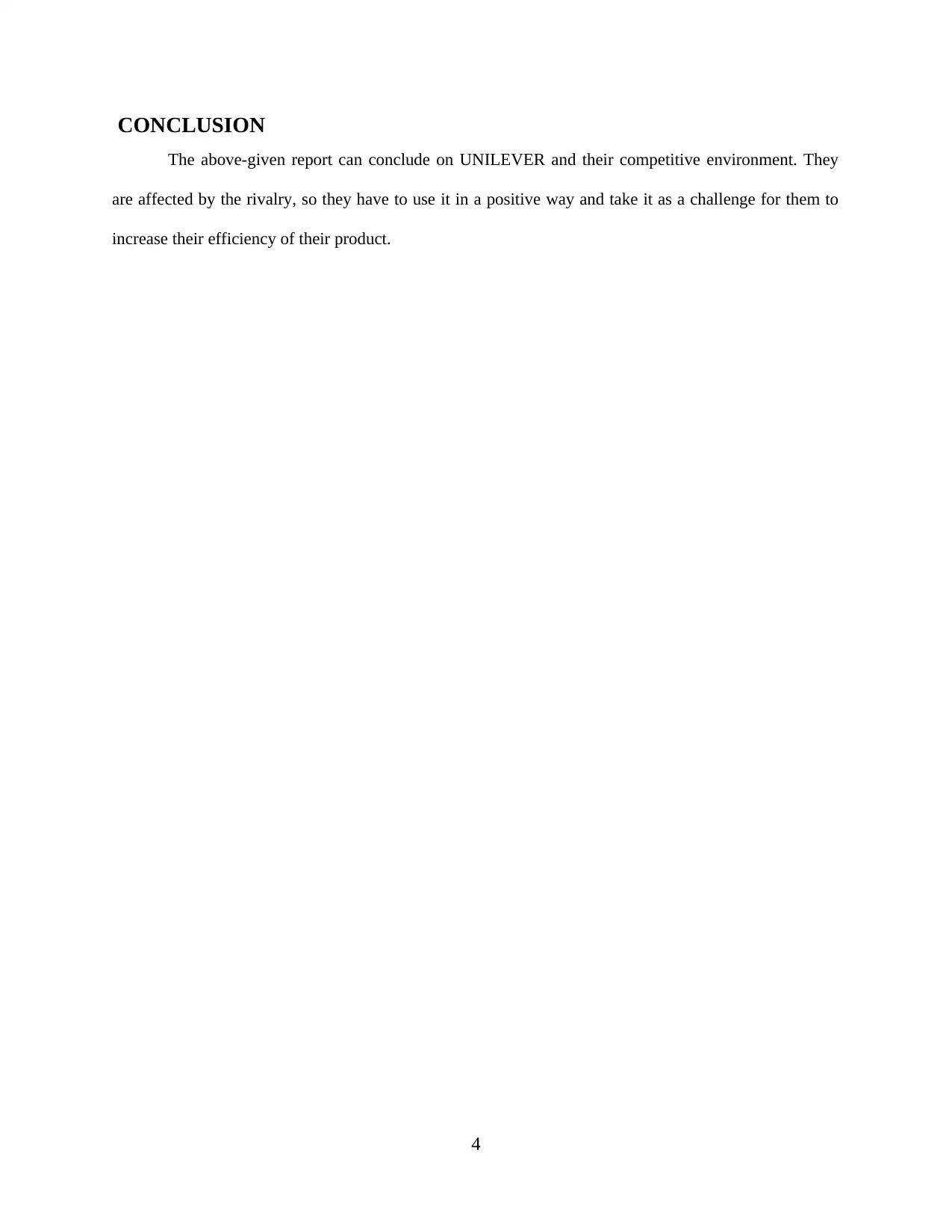
CONCLUSION
The above-given report can conclude on UNILEVER and their competitive environment. They
are affected by the rivalry, so they have to use it in a positive way and take it as a challenge for them to
increase their efficiency of their product.
4
The above-given report can conclude on UNILEVER and their competitive environment. They
are affected by the rivalry, so they have to use it in a positive way and take it as a challenge for them to
increase their efficiency of their product.
4
⊘ This is a preview!⊘
Do you want full access?
Subscribe today to unlock all pages.

Trusted by 1+ million students worldwide
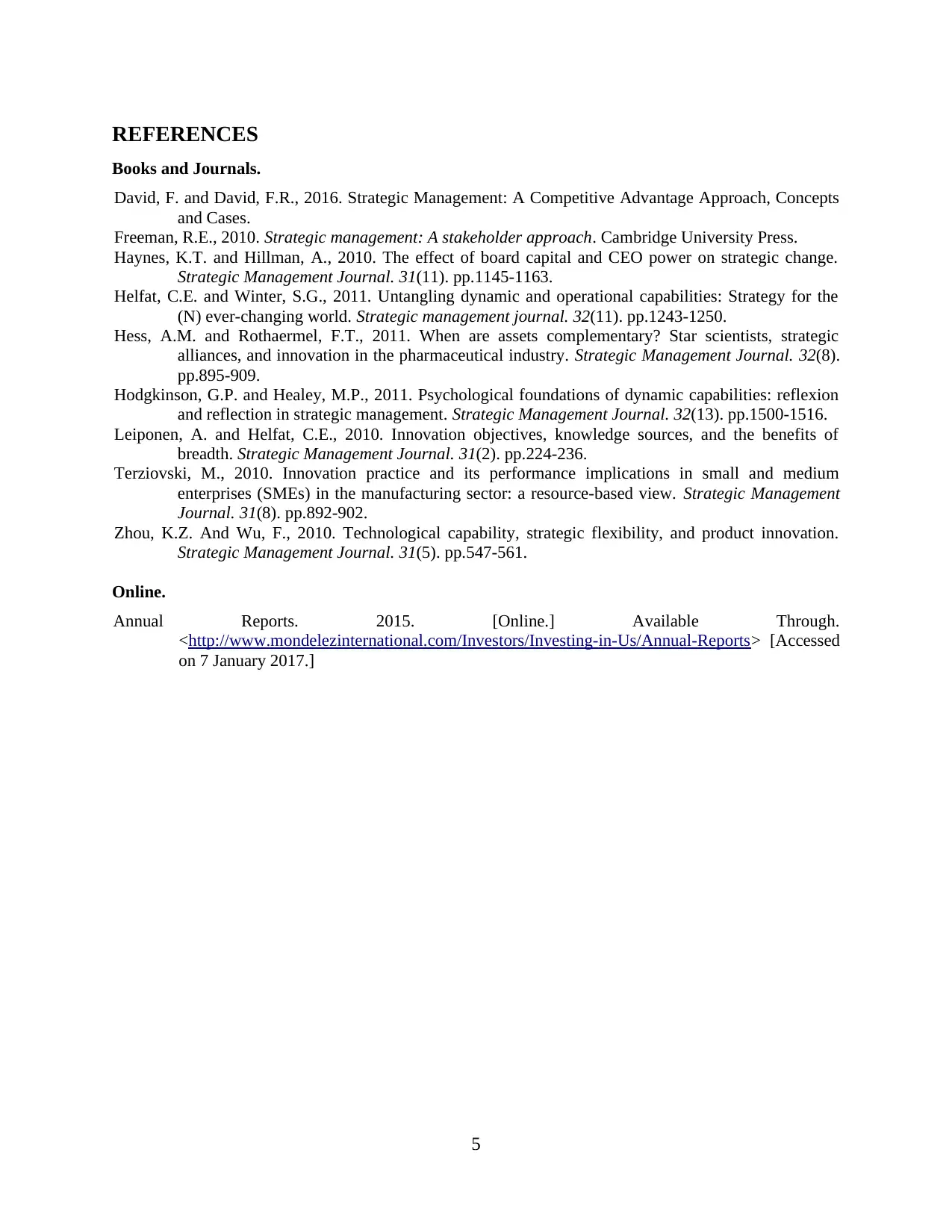
REFERENCES
Books and Journals.
David, F. and David, F.R., 2016. Strategic Management: A Competitive Advantage Approach, Concepts
and Cases.
Freeman, R.E., 2010. Strategic management: A stakeholder approach. Cambridge University Press.
Haynes, K.T. and Hillman, A., 2010. The effect of board capital and CEO power on strategic change.
Strategic Management Journal. 31(11). pp.1145-1163.
Helfat, C.E. and Winter, S.G., 2011. Untangling dynamic and operational capabilities: Strategy for the
(N) ever‐changing world. Strategic management journal. 32(11). pp.1243-1250.
Hess, A.M. and Rothaermel, F.T., 2011. When are assets complementary? Star scientists, strategic
alliances, and innovation in the pharmaceutical industry. Strategic Management Journal. 32(8).
pp.895-909.
Hodgkinson, G.P. and Healey, M.P., 2011. Psychological foundations of dynamic capabilities: reflexion
and reflection in strategic management. Strategic Management Journal. 32(13). pp.1500-1516.
Leiponen, A. and Helfat, C.E., 2010. Innovation objectives, knowledge sources, and the benefits of
breadth. Strategic Management Journal. 31(2). pp.224-236.
Terziovski, M., 2010. Innovation practice and its performance implications in small and medium
enterprises (SMEs) in the manufacturing sector: a resource‐based view. Strategic Management
Journal. 31(8). pp.892-902.
Zhou, K.Z. And Wu, F., 2010. Technological capability, strategic flexibility, and product innovation.
Strategic Management Journal. 31(5). pp.547-561.
Online.
Annual Reports. 2015. [Online.] Available Through.
<http://www.mondelezinternational.com/Investors/Investing-in-Us/Annual-Reports> [Accessed
on 7 January 2017.]
5
Books and Journals.
David, F. and David, F.R., 2016. Strategic Management: A Competitive Advantage Approach, Concepts
and Cases.
Freeman, R.E., 2010. Strategic management: A stakeholder approach. Cambridge University Press.
Haynes, K.T. and Hillman, A., 2010. The effect of board capital and CEO power on strategic change.
Strategic Management Journal. 31(11). pp.1145-1163.
Helfat, C.E. and Winter, S.G., 2011. Untangling dynamic and operational capabilities: Strategy for the
(N) ever‐changing world. Strategic management journal. 32(11). pp.1243-1250.
Hess, A.M. and Rothaermel, F.T., 2011. When are assets complementary? Star scientists, strategic
alliances, and innovation in the pharmaceutical industry. Strategic Management Journal. 32(8).
pp.895-909.
Hodgkinson, G.P. and Healey, M.P., 2011. Psychological foundations of dynamic capabilities: reflexion
and reflection in strategic management. Strategic Management Journal. 32(13). pp.1500-1516.
Leiponen, A. and Helfat, C.E., 2010. Innovation objectives, knowledge sources, and the benefits of
breadth. Strategic Management Journal. 31(2). pp.224-236.
Terziovski, M., 2010. Innovation practice and its performance implications in small and medium
enterprises (SMEs) in the manufacturing sector: a resource‐based view. Strategic Management
Journal. 31(8). pp.892-902.
Zhou, K.Z. And Wu, F., 2010. Technological capability, strategic flexibility, and product innovation.
Strategic Management Journal. 31(5). pp.547-561.
Online.
Annual Reports. 2015. [Online.] Available Through.
<http://www.mondelezinternational.com/Investors/Investing-in-Us/Annual-Reports> [Accessed
on 7 January 2017.]
5
1 out of 7
Related Documents
Your All-in-One AI-Powered Toolkit for Academic Success.
+13062052269
info@desklib.com
Available 24*7 on WhatsApp / Email
![[object Object]](/_next/static/media/star-bottom.7253800d.svg)
Unlock your academic potential
Copyright © 2020–2025 A2Z Services. All Rights Reserved. Developed and managed by ZUCOL.




